How to Cook the Perfect Steak — 🥩🙌🏻 Learn how to cook the perfect steak on the stovetop, every time! Which cut and grade of meat to choose, what temperature, what skillet, and how long to cook it. Plus, there are all the TIPS and TRICKS you need to know are included so you can make the BEST steak at home to rival a fancy steakhouse every single time!

Table of Contents
- Cooking the Perfect Steak
- Ingredients for the Best Steak
- How to Cook the Perfect Steak on the Stove
- Important Tips For Cooking a Perfect Steak
- Finishing Stovetop Steaks in the Oven
- How to Grill a Perfect Steak
- What to Serve with Steak
- Storage
- Recipe FAQs
- How To Cook A Perfect Steak Recipe
- Favorite Beef Recipes:
Cooking the Perfect Steak
So many of us, so often, are completely baffled about how to cook the perfect steak.
Apart from that, it can be confusing to decide what cut of steak to use, as well as the grade of beef, to marinate or not, and how long to even cook the steak.
I am here to take the guesswork out of how to cook the perfect steak every single time.
Not only will you love digging into a perfectly cooked steak however you personally define perfect, but your friends and family will also be impressed with your steak superstar cooking powers!
Now you won’t need to rely on an overpriced or fancy steakhouse in order to enjoy a great steak when you can do it at home, on your stovetop and oven.

Ingredients for the Best Steak
There are endless ways to cook steak, but my favorite failproof method is to use a marinade. Luckily, it comes together with a handful of simple ingredients. Here’s what you’ll need:
- Optional Steak Marinade – My homemade marinade includes olive oil, minced garlic cloves, balsamic vinegar, Worcestershire sauce, soy sauce (I use lite or reduced-sodium), Dijon mustard, fresh rosemary, fresh thyme, black pepper, and lime juice
- Steak – Use any cut steak you like best. For the best result, look for steaks that are roughly equal in size
- Olive oil
- Butter – Salted or unsalted butter is fine
- Garlic
- Salt
- Black pepper
Note: Scroll down to the recipe card section of the post for the ingredients with amounts included and for more complete directions.
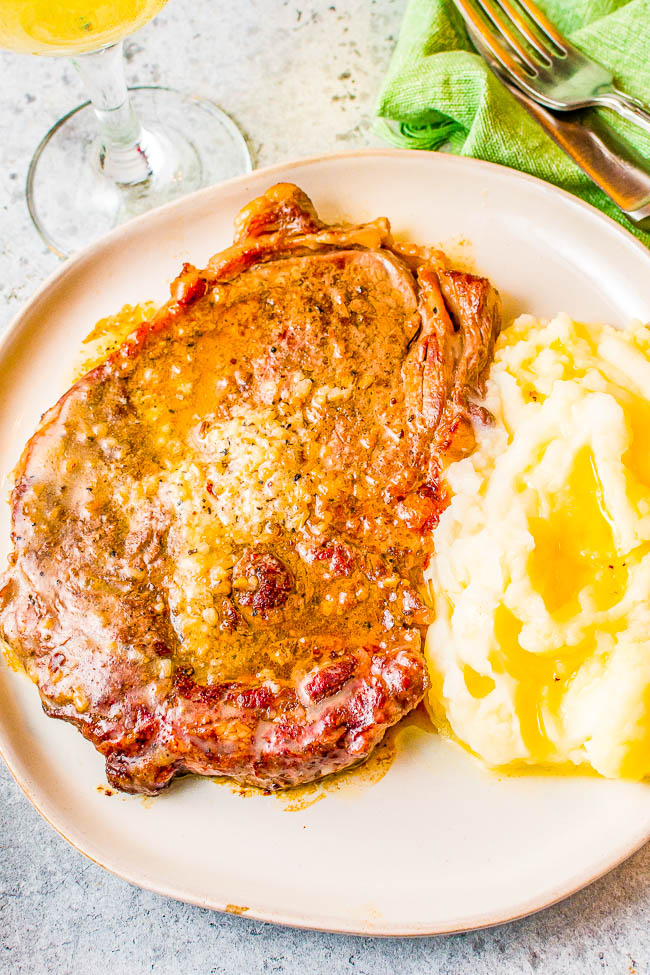
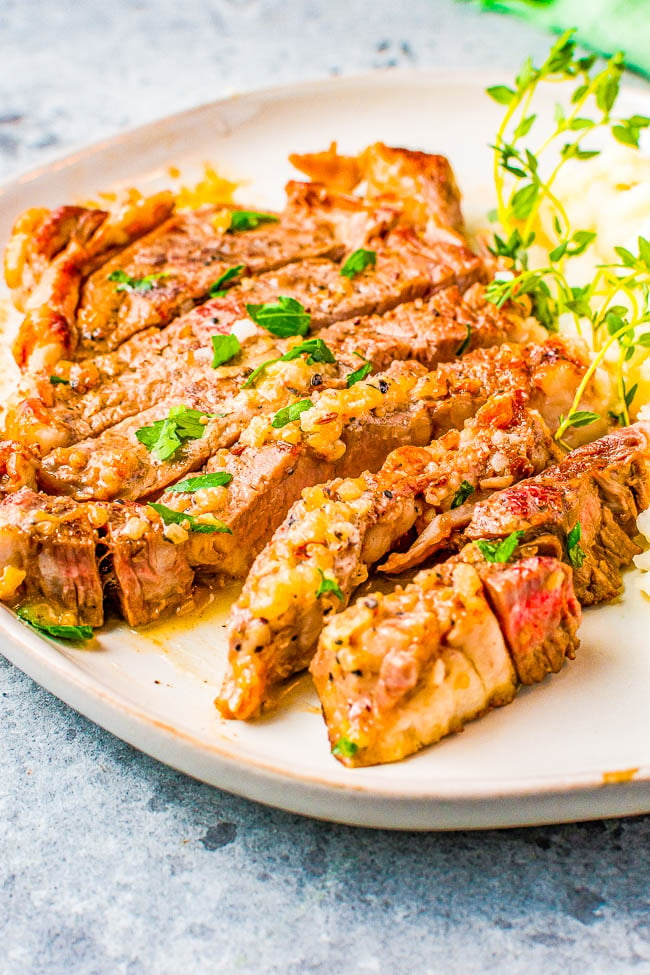
How to Cook the Perfect Steak on the Stove
Cooking steak on the stove and then finishing it in the oven is the best method for cooking steak, in my experience. Before you begin, Preheat the oven to 450°F, and heat a cast iron pan or skillet to sizzling, either in the hot oven or on the stovetop. You’ll know it’s hot enough when a water droplet will sizzle and evaporate immediately.
Here’s an overview of the best way to cook steak on the stove:
- Combine all the marinade ingredients. Let the steak and marinade come to room temperature. Add the steak, and let it stand for 10 minutes. Then, transfer it to the fridge, and marinate for at least 1 hour or up to 24 hours. Discard any marinade that touched the raw meat before cooking.
- Pat the steaks dry with a clean paper towel, and add a light drizzle of olive oil if using. Season to taste, and place the steaks on the sizzling skillet, making sure to leave space between each piece.
- Cook until the steaks move easily in the pan, flip, and continue to cook to your desired doneness. Use tongs to hold a steak up to sear the edges. Don’t forget this step!
- After the butter has melted, take the steak out of the skillet, and allow it to rest for 5 minutes on a cutting board or plate. It will be perfect when you slice it!
- Remove the skillet from the oven, put butter and garlic on top of each steak divided evenly, and allow the butter to melt, adding to the caramelization and the flavor. As the butter melts, you can spoon some back on top for a bit to keep it marinating in the butter.


Important Tips For Cooking a Perfect Steak
- To warm the skillet, you can heat the oven to 400°F, put the skillet inside, and heat it up that way as well. Remove the skillet (remember to use a hot mitt) and put it on a hot burner to cook the steak.
- Do not use a nonstick pan, it doesn’t hold the heat enough for a steak and doesn’t cook evenly. Cast iron is best.
- If using a frozen steak, completely thaw first.
- Let a refrigerated steak sit out for 30 minutes before cooking. A cold steak doesn’t cook evenly. The inside won’t cook while the outside may get overdone.
- Don’t spray or oil the pan. A dry pan is best!
- Place the steak in the sizzling hot pan and let it be. Don’t push down on it or poke it.
- When you flip the steak, add a pat of butter (seasoned butter is nice as well). This will melt into the steak and help baste it and it helps to caramelize the crust.
- For an evenly cooked steak, once you have seared the steak, you can place the pan in a 450° oven for 3-10 minutes.
- Always remove the steak when it is 5°F below the desired final cooked temperature. Meat will continue to cook (carryover cooking) even once removed from the heat, so don’t overcook.
- Always let a steak rest for 3 to 5 minutes before cutting. This will keep the meat moist. If you cut it too soon, the juices will run out leaving a dryer steak.
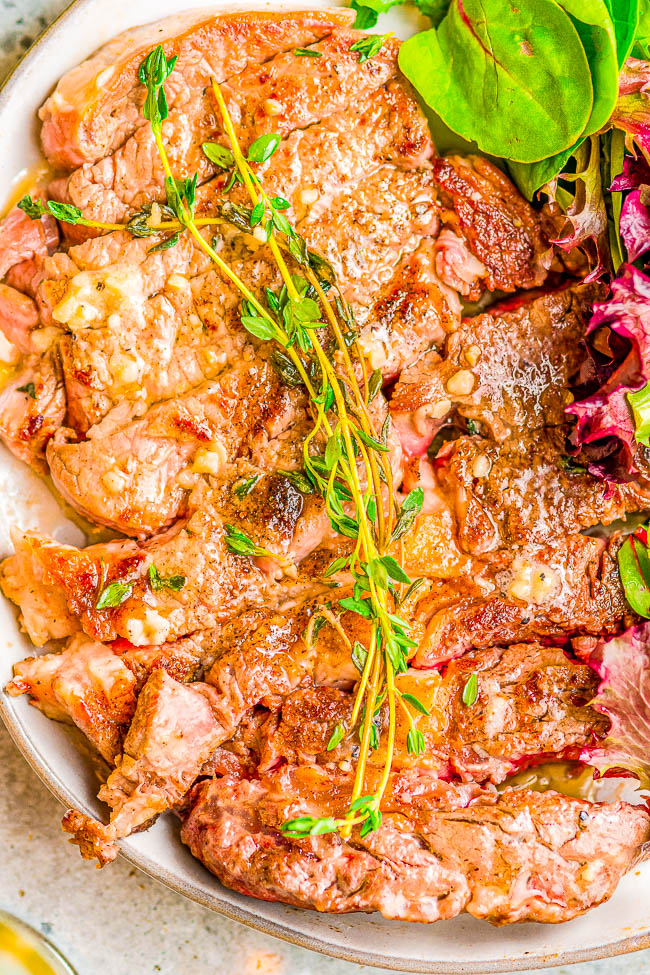

Finishing Stovetop Steaks in the Oven
If you want to cook your stovetop steaks to medium-rare or more, you’ll need to finish them in the oven. This is why I recommend cooking steak in cast iron skillets — they are also oven-safe and evenly distribute heat, which prevents steaks from burning.
After you’ve finished cooking steak on the stove, here are the next steps to finishing off a perfect pan-seared steak:
– After using tongs to get some char on all sides, place the skillet in the oven for 3 to 10 minutes.
– Use a meat thermometer to check for doneness. The meat should be 5° less than the temperature you want. It will continue to cook even when it is removed from the oven, a process known as carryover cooking. For example, if you want a steak that is well done, meaning 155°F to 164°F the thermometer should read 150°F.
– Remove the pan from the oven, remove the steak from the pan, place it on a cutting board or plate, and allow it to sit for 5 minutes, and your steak will carryover-cook, it will come up to temperature, and it should be perfect. When you remove the steak from the oven, put butter and garlic on top and let it melt and this will add to the caramelization and the flavor.
– As the butter melts, you can spoon some back on top for a bit to keep it marinating in the butter.
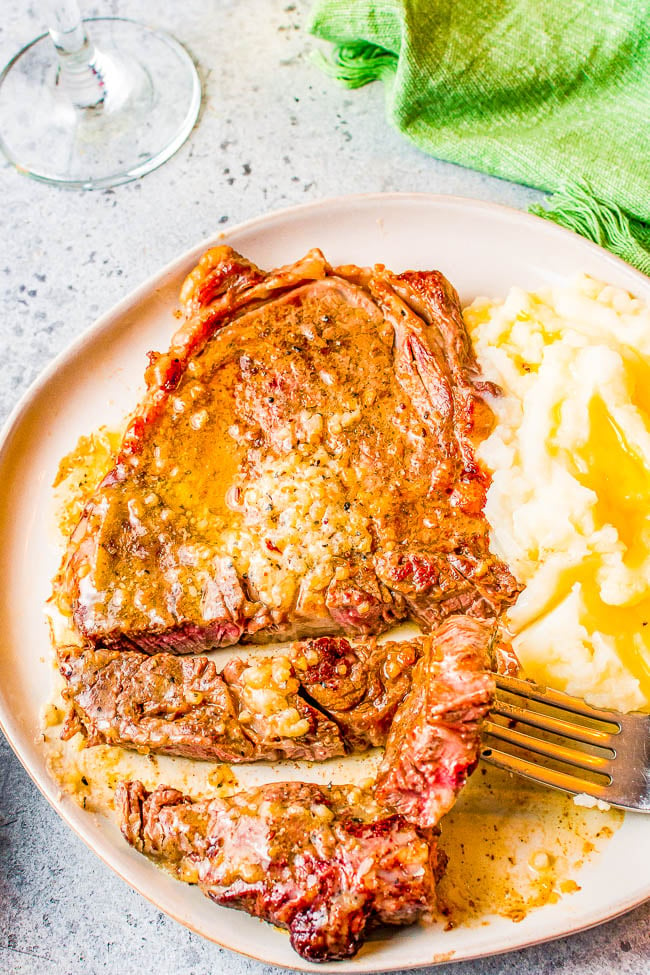

How to Grill a Perfect Steak
While this post is dedicated to going into great detail about how to cook a perfect steak on the stovetop and then finishing it in the oven if desired, here a couple notes about grilling steak.
- First, pay attention to how hot your grill is. Grills have hot spots and cooler spots. Cook your steak on the hot spot although you don’t want your grill to be at 600F or anything. Try to keep it in the 450F range.
- Don’t try to force-flipping it. The same goes here as for indoor cooking on your stove. If it’s sticking, it’s not ready. Don’t force it, just let it be.
- Don’t press on it with tongs either since you will just be forcing the juices out creating a dryer, tougher steak.
- Cook it until the internal temp reaches what you are desiring in terms of a steak, such as medium rare or well done or however you like your steak.
- Remember to take it off the grill 5 degrees below the final desired temperature range. Use a thermometer to make sure you’re not just guessing!
- And finally, let that baby rest because if not, you’re just going to be letting those great natural juices run out all over your cutting board which is not where they belong.


What to Serve with Steak


Storage
In the Refrigerator: Leftover steak will stay fresh in an airtight container in the fridge for up to 4 days.
In the Freezer: Cooked steak is best served freshly cooked, but you can freeze leftovers for up to 2 months.
To Serve: Thaw frozen steak in the fridge overnight. Enjoy cold, or warm it for a few seconds in the microwave or in a skillet over medium heat.



Recipe FAQs
Below are our four favorite steaks, and the most common cuts of steak, although there are many more out there.
Here are four common cuts of steak:
– Rib eye — This has a high-fat content, making it a very flavorful steak. Do not remove the fat before cooking. It adds tons of flavor! You can cut off the fat when you are eating the meat after it’s cooked. No need to marinade ribeye, it’s perfect with a little salt and pepper or steak seasoning.
– Sirloin —This steak doesn’t have much fat and is best cooked to medium only. Sirloin is great with a dry rub.
– Filet Mignon — This is a small round steak that doesn’t have much fat or marbling. It is my personal favorite because it is so tender. It will dry out fast and is best eaten rare. Just cook with a bit of salt and pepper for the best flavor.
– T-Bone or Porterhouse — These steaks always come with a T-bone in the middle and a steak on each side. One side is the strip steak, sold as a New York strip steak, and the other is the filet. A porterhouse usually has more of the filet on it. Use a meat thermometer to cook this steak so you can get it right.
There are 3 grades of meat — Select, Choice, and Prime.
Here is a quick breakdown of each:
Select — Lower, cheaper-grade meat that is usually advertised for sales. Often more fat, more bones, and not a good quality.
Choice — A better quality meat worth paying more for.
Prime — The good stuff and worth every penny!
I definitely recommend going with choice or prime steaks so that you really enjoy your steak!
This is such a personal preference because as you know, some people love really well done steak, and others like it practically still moving!
Here is the general consensus on what signifies rare to well-done steaks and the corresponding steak internal temperatures associated:
– Rare steak — 120°F to 129°F. Cooler and bright red center, soft to the touch.
– Medium rare steak — 130°F to 134°F. Warm red center, beginning to firm up with red juices.
– Medium steak — 135°F to 144°F. Warm pink center, brown on the edges, firm with red juices.
– Medium well steak — 145°F to 154°F. Slightly pink center, completely firm with brown juices.
– Well done steak — 155°F to 164°F. Very little to no pink, firm to the touch.
To cook a thin flank steak to medium versus cooking a much thicker filet to medium, the amount of cooking time will vary based on the thickness and cut of meat.
If you are looking for a medium steak, you need to aim for the final temperature to fall in the range of 135°F to 144°F, however long it takes to reach that particular temperature.
Take note, you should remove the steak from the skillet and let it rest when it is 5°F under the desired temperature or temperature range because you need to account for the carryover cooking that will occur.
I highly recommend you use a thermometer to eliminate guesswork!
For tender cuts like filets or ribeye, you need less than 4 hours. For less expensive, tougher meat you can marinade for up to 24 hours.
Be generous with the marinade for tough meats. This will help to tenderize as well as flavor the meat.
Yes! If you don’t use all the marinade you prepped (but before the meat touched it), freeze it in ice cube trays for future use.



Pin This Recipe
Enjoy AverieCooks.com Without Ads! 🆕
Go Ad Free

How To Cook A Perfect Steak
Equipment
- 1 Bowl
- 1 Cast-Iron Skillet
- 1 Kitchen Tongs
Ingredients
Steak Marinade (optional)
- ¼ cup olive oil
- 2 teaspoons minced garlic
- 3 tablespoons balsamic vinegar
- 3 tablespoons Worcestershire sauce
- 3 tablespoons soy sauce, I use lite or reduced-sodium
- 1 tablespoon dijon mustard
- 1 teaspoon fresh rosemary, chopped (dry may be substituted)
- 2 sprigs fresh thyme, chopped (dry may be substituted)
- 1 teaspoon freshly ground black pepper
- Juice from 1 medium lime
Steak
- 2 steaks, your choice of cut and weight
- Olive oil, to taste; optional
- 3 tablespoons butter, not margarine, salted or unsalted; divided
- 1 teaspoon garlic, finely minced; divied
- Salt, to taste
- Freshly ground black pepper, to taste
Instructions
Steak Marinade, optional:
- Combine all the ingredients, stir, and pour over the meat. Marinate for 1 to 24 hours.
- Discard the marinade after using. However, extra unused (never touched the meet) marinade can be frozen for up to 3 months.
Steak:
- Preheat the oven to 450°F and heat a a cast iron skillet to sizzling, either in the hot oven or on the stovetop.*
- Pat the steaks dry and if you prefer, you can rub a small amount of olive oil over the steaks.
- Season with salt and pepper, to taste.
- Place the steaks in the sizzling hot skillet, making sure that they’re not touching or crowded.
- Let the steaks cook for about 2 minutes before testing to see if they move easily in the pan. If they are stuck, do not try and unstick them. They are not ready yet. Do not press on the steaks while cooking. This will press the natural juices out. Just let them be.
- When the steak comes loose from the pan, flip it over, and cook the other side until it comes loose.
- Use tongs and hold so the sides of the steak get charred all the way around.
- If you like a rare steak, you can stop here. However first, just add some butter to the top of each steak (about 1 1/2 tablespoons each; a generous pat of butter) and let it melt, add some minced garlic (about 1/2 teaspoon each) and let it sit and “cook” a bit on top of the meat.
- Remove the meat from the skillet and let it rest for 5 to 7 minutes before cutting so the juices will stay in the meat keeping it moist and delicious.
- If you like a steak more medium to well done, place the skillet in the oven for 3 to 10 minutes.
- Use a meat thermometer to check for doneness. The meat should be 5°F less than the temperature you ultimately want because it will continue to cook (carryover cooking) even when it is removed from the oven.
- Remove the skillet from the oven, put butter and garlic on top of each steak divided evenly, and allow the butter to melt, adding to the caramelization and the flavor. As the butter melts, you can spoon some back on top for a bit to keep it marinating in the butter.
- After the butter has melted, take the steak out of the skillet, and allow it to rest for 5 minutes on a cutting board or plate, and it will be perfect when you slice it.
- Serve with your favorite side dish such as The Best Mashed Potatoes. Leftover steak may be stored airtight in the fridge for up to 4 days and in the freezer for up to 2 months however steak is always best freshly cooked.
Notes
Nutrition
Nutrition information is automatically calculated, so should only be used as an approximation.
©averiecooks.com. Content and photographs are copyright protected. Sharing of this recipe is both encouraged and appreciated. Copying and/or pasting full recipes to any social media is strictly prohibited.
Favorite Beef Recipes:
Teriyaki Steak Tips – Tri-tip steak tips cook to perfection and are topped with a thick and sticky homemade pineapple teriyaki sauce! A family favorite that everyone will love and is FAST and EASY to make!

Grilled Steak Kabobs — Juicy steak with sweet bell peppers, onions, zucchini, and pineapple for the PERFECT sweet-and-savory kabob! You’ll want to fire up your grill for these! Fast, EASY, zero cleanup, and DELISH!

Mongolian Beef Bowls – These EASY Chinese-inspired Mongolian beef bowls are ready in just 10 minutes! Loaded with rich savory flavor, crisp-tender vegetables, and served over rice! Faster than calling for takeout when you’re craving Asian food!

Better-Than-Takeout Beef and Broccoli — It really is BETTER than takeout and it’s definitely FASTER! This EASY Chinese restaurant copycat recipe is a family favorite that’ll go into your regular rotation!
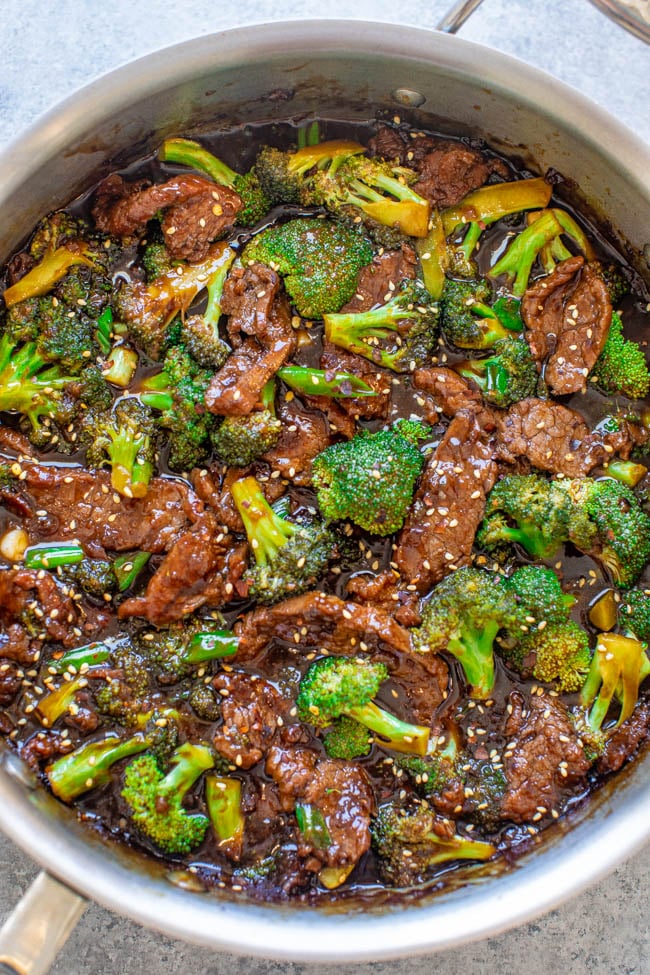
15-Minute Sheet Pan Chinese Beef and Broccoli — EASY, HEALTHIER than going out for Chinese because it’s baked, and FASTER than calling for takeout! So much FLAVOR in this family favorite! It’ll go into your regular rotation!

Copycat P.F. Chang’s Mongolian Beef — Comes together in 20 minutes and makes for a great weeknight meal! Even picky eaters will love this, and any leftover sauce can be served over rice.





great